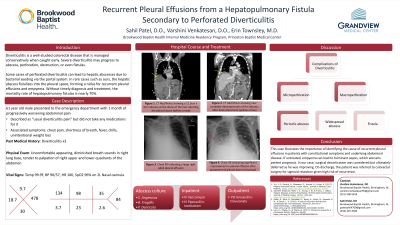Monday Poster Session
Category: Colon
P2038 - Recurrent Pleural Effusions From Hepatopulmonary Fistula Secondary to Perforated Diverticulitis
Monday, October 28, 2024
10:30 AM - 4:00 PM ET
Location: Exhibit Hall E

Has Audio
.jpg)
Sahil M. Patel, DO
Brookwood Baptist Health
Birmingham, AL
Presenting Author(s)
Sahil M. Patel, DO, Varshini Venkatesan, DO, Lauren L. Pacheco, MD
Brookwood Baptist Health, Birmingham, AL
Introduction: Diverticulitis is a well-studied colorectal disease that is mostly managed conservatively. Severe diverticulitis may progress to pericolic abscess or perforation when not caught early. Patients with diverticulitis are predisposed to hepatic abscesses via seeding through the portal system. In rare cases such as ours, the hepatic abscesses lead to a hepatopulmonary fistula, causing recurrent symptomatic pleural effusions.
Case Description/Methods: A 61-year-old male with past medical history of right-sided diverticulitis presented to the emergency department with a 2-week history of worsening abdominal pain and a 2-day history of chest pain and dyspnea. On physical exam, he was diaphoretic, tachycardic at 120 bpm, and hypotensive at 84/42 mmHg. Chest X-ray revealed a moderate-sized right-sided pleural effusion. CT scan of abdomen and pelvis with IV contrast showed multiple large air-fluid collections surrounding the liver with one collection near the dome of the liver that fistulized to the right lower lobe of the lung. There was also notable wall thickening of the cecum and ascending colon with surrounding inflammation, suggesting diverticulitis. Due to his hemodynamic instability, sepsis protocol was initiated, including treatment with broad-spectrum IV antibiotics. CT-guided drainage catheter was placed within the liver abscess and intracatheter contrast confirmed a fistulous tract into the right lower lobe of the lung. A chest tube was placed to drain the pleural effusion, and fluid culture was positive for S. anginosus, B. fragillis, and Prevotella, indicating a clear abdominal source. The patient’s hospital course was prolonged due to the refractory nature of his pleural effusions, but with targeted antibiotic therapy and respiratory support, he improved and was discharged with a 6-week course of amoxicillin-clavulanate.
Discussion: Up to 25% of patients with diverticulitis develop complications. While some complications such as microperforations cause contained pericolic abscesses, macroperforations cause colo-colonic fistulas or widespread abscesses throughout the abdomen, including the liver. If left untreated, it can lead to fulminant sepsis, significantly worsening the patient’s prognosis. In our case, the CT scan was crucial in identifying the hepatopulmonary fistula early, allowing us to drain the abscess promptly. Surgical decortication would have likely been pursued if the patient had not improved with time.
Disclosures:
Sahil M. Patel, DO, Varshini Venkatesan, DO, Lauren L. Pacheco, MD. P2038 - Recurrent Pleural Effusions From Hepatopulmonary Fistula Secondary to Perforated Diverticulitis, ACG 2024 Annual Scientific Meeting Abstracts. Philadelphia, PA: American College of Gastroenterology.
Brookwood Baptist Health, Birmingham, AL
Introduction: Diverticulitis is a well-studied colorectal disease that is mostly managed conservatively. Severe diverticulitis may progress to pericolic abscess or perforation when not caught early. Patients with diverticulitis are predisposed to hepatic abscesses via seeding through the portal system. In rare cases such as ours, the hepatic abscesses lead to a hepatopulmonary fistula, causing recurrent symptomatic pleural effusions.
Case Description/Methods: A 61-year-old male with past medical history of right-sided diverticulitis presented to the emergency department with a 2-week history of worsening abdominal pain and a 2-day history of chest pain and dyspnea. On physical exam, he was diaphoretic, tachycardic at 120 bpm, and hypotensive at 84/42 mmHg. Chest X-ray revealed a moderate-sized right-sided pleural effusion. CT scan of abdomen and pelvis with IV contrast showed multiple large air-fluid collections surrounding the liver with one collection near the dome of the liver that fistulized to the right lower lobe of the lung. There was also notable wall thickening of the cecum and ascending colon with surrounding inflammation, suggesting diverticulitis. Due to his hemodynamic instability, sepsis protocol was initiated, including treatment with broad-spectrum IV antibiotics. CT-guided drainage catheter was placed within the liver abscess and intracatheter contrast confirmed a fistulous tract into the right lower lobe of the lung. A chest tube was placed to drain the pleural effusion, and fluid culture was positive for S. anginosus, B. fragillis, and Prevotella, indicating a clear abdominal source. The patient’s hospital course was prolonged due to the refractory nature of his pleural effusions, but with targeted antibiotic therapy and respiratory support, he improved and was discharged with a 6-week course of amoxicillin-clavulanate.
Discussion: Up to 25% of patients with diverticulitis develop complications. While some complications such as microperforations cause contained pericolic abscesses, macroperforations cause colo-colonic fistulas or widespread abscesses throughout the abdomen, including the liver. If left untreated, it can lead to fulminant sepsis, significantly worsening the patient’s prognosis. In our case, the CT scan was crucial in identifying the hepatopulmonary fistula early, allowing us to drain the abscess promptly. Surgical decortication would have likely been pursued if the patient had not improved with time.
Disclosures:
Sahil Patel indicated no relevant financial relationships.
Varshini Venkatesan indicated no relevant financial relationships.
Lauren Pacheco indicated no relevant financial relationships.
Sahil M. Patel, DO, Varshini Venkatesan, DO, Lauren L. Pacheco, MD. P2038 - Recurrent Pleural Effusions From Hepatopulmonary Fistula Secondary to Perforated Diverticulitis, ACG 2024 Annual Scientific Meeting Abstracts. Philadelphia, PA: American College of Gastroenterology.
